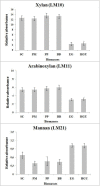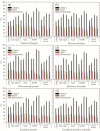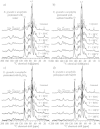Evaluating the composition and processing potential of novel sources of Brazilian biomass for sustainable biorenewables production
- PMID: 24438499
- PMCID: PMC4028816
- DOI: 10.1186/1754-6834-7-10
Evaluating the composition and processing potential of novel sources of Brazilian biomass for sustainable biorenewables production
Abstract
Background: The search for promising and renewable sources of carbohydrates for the production of biofuels and other biorenewables has been stimulated by an increase in global energy demand in the face of growing concern over greenhouse gas emissions and fuel security. In particular, interest has focused on non-food lignocellulosic biomass as a potential source of abundant and sustainable feedstock for biorefineries. Here we investigate the potential of three Brazilian grasses (Panicum maximum, Pennisetum purpureum and Brachiaria brizantha), as well as bark residues from the harvesting of two commercial Eucalyptus clones (E. grandis and E. grandis x urophylla) for biofuel production, and compare these to sugarcane bagasse. The effects of hot water, acid, alkaline and sulfite pretreatments (at increasing temperatures) on the chemical composition, morphology and saccharification yields of these different biomass types were evaluated.
Results: The average yield (per hectare), availability and general composition of all five biomasses were compared. Compositional analyses indicate a high level of hemicellulose and lignin removal in all grass varieties (including sugarcane bagasse) after acid and alkaline pretreatment with increasing temperatures, whilst the biomasses pretreated with hot water or sulfite showed little variation from the control. For all biomasses, higher cellulose enrichment resulted from treatment with sodium hydroxide at 130°C. At 180°C, a decrease in cellulose content was observed, which is associated with high amorphous cellulose removal and 5-hydroxymethyl-furaldehyde production. Morphological analysis showed the effects of different pretreatments on the biomass surface, revealing a high production of microfibrillated cellulose on grass surfaces, after treatment with 1% sodium hydroxide at 130°C for 30 minutes. This may explain the higher hydrolysis yields resulting from these pretreatments, since these cellulosic nanoparticles can be easily accessed and cleaved by cellulases.
Conclusion: Our results show the potential of three Brazilian grasses with high productivity yields as valuable sources of carbohydrates for ethanol production and other biomaterials. Sodium hydroxide at 130°C was found to be the most effective pretreatment for enhanced saccharification yields. It was also efficient in the production of microfibrillated cellulose on grass surfaces, thereby revealing their potential as a source of natural fillers used for bionanocomposites production.
Figures












Similar articles
-
Effects of pretreatment on morphology, chemical composition and enzymatic digestibility of eucalyptus bark: a potentially valuable source of fermentable sugars for biofuel production - part 1.Biotechnol Biofuels. 2013 May 9;6(1):75. doi: 10.1186/1754-6834-6-75. Biotechnol Biofuels. 2013. PMID: 23657132 Free PMC article.
-
Evaluation of lime and hydrothermal pretreatments for efficient enzymatic hydrolysis of raw sugarcane bagasse.Biotechnol Biofuels. 2015 Dec 2;8:205. doi: 10.1186/s13068-015-0384-y. eCollection 2015. Biotechnol Biofuels. 2015. PMID: 26633992 Free PMC article.
-
Improvement of ethanol and biogas production from sugarcane bagasse using sodium alkaline pretreatments.J Environ Manage. 2018 Nov 15;226:329-339. doi: 10.1016/j.jenvman.2018.08.058. Epub 2018 Aug 17. J Environ Manage. 2018. PMID: 30125812
-
Cellulosic and hemicellulosic fractions of sugarcane bagasse: Potential, challenges and future perspective.Int J Biol Macromol. 2021 Feb 1;169:564-582. doi: 10.1016/j.ijbiomac.2020.12.175. Epub 2020 Dec 29. Int J Biol Macromol. 2021. PMID: 33385447 Review.
-
Lignocellulosic Biomass: A Sustainable Bioenergy Source for the Future.Protein Pept Lett. 2018;25(2):148-163. doi: 10.2174/0929866525666180122144504. Protein Pept Lett. 2018. PMID: 29359659 Review.
Cited by
-
Quantitative (13)C MultiCP solid-state NMR as a tool for evaluation of cellulose crystallinity index measured directly inside sugarcane biomass.Biotechnol Biofuels. 2015 Aug 5;8:110. doi: 10.1186/s13068-015-0292-1. eCollection 2015. Biotechnol Biofuels. 2015. PMID: 26244055 Free PMC article.
-
Chemical and Resistive Switching Properties of Elaeodendron buchananii Extract-Carboxymethyl Cellulose Composite: A Potential Active Layer for Biodegradable Memory Devices.Polymers (Basel). 2024 Oct 21;16(20):2949. doi: 10.3390/polym16202949. Polymers (Basel). 2024. PMID: 39458777 Free PMC article.
-
Enzymatic Pretreatment with Laccases from Lentinus sajor-caju Induces Structural Modification in Lignin and Enhances the Digestibility of Tropical Forage Grass (Panicum maximum) Grown under Future Climate Conditions.Int J Mol Sci. 2021 Aug 31;22(17):9445. doi: 10.3390/ijms22179445. Int J Mol Sci. 2021. PMID: 34502353 Free PMC article.
-
Characterization of a thermophilic cellulase from Geobacillus sp. HTA426, an efficient cellulase-producer on alkali pretreated of lignocellulosic biomass.PLoS One. 2017 Apr 13;12(4):e0175004. doi: 10.1371/journal.pone.0175004. eCollection 2017. PLoS One. 2017. PMID: 28406925 Free PMC article.
-
Bioethanol production from Ficus fruits (Ficus cunia) by Fusarium oxysporum through consolidated bioprocessing system.3 Biotech. 2022 Sep;12(9):178. doi: 10.1007/s13205-022-03234-y. Epub 2022 Jul 18. 3 Biotech. 2022. PMID: 35865259 Free PMC article.
References
-
- Havlík P, Schneider UA, Schmid E, Böttcher H, Fritz S, Skalský R, Aoki K, Cara SD, Kindermann G, Kraxner F, Leduc S, McCallum I, Mosnier A, Sauer T, Obersteiner M. Global land-use implications of first and second generation biofuel targets. Energy Policy. 2011;39:5690–5702. doi: 10.1016/j.enpol.2010.03.030. - DOI
-
- Rosegrant MW, Zhu T, Msangi S, Sulser T. Global scenarios for biofuels: impacts and implications. App Econ Perspect Policy. 2008;30:495–505.
-
- Lora ES, Andrade RV. Biomass as energy source in Brazil. Renew Sust Energ Rev. 2009;13:777–788. doi: 10.1016/j.rser.2007.12.004. - DOI
-
- La Rovere EL, Pereira AS, Simões AF. Biofuels and sustainable energy development in Brazil. World Dev. 2011;39:1026–1036. doi: 10.1016/j.worlddev.2010.01.004. - DOI
Grants and funding
LinkOut - more resources
Full Text Sources
Other Literature Sources
Molecular Biology Databases

